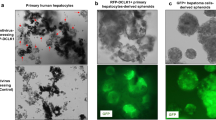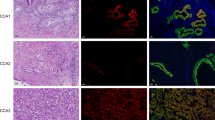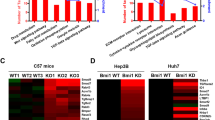Abstract
Transforming growth factor-β (TGF-β) signaling members, TGF-β receptor type II (TBRII), Smad2, Smad4 and Smad adaptor, embryonic liver fodrin (ELF), are prominent tumor suppressors in gastrointestinal cancers. Here, we show that 40% of elf+/− mice spontaneously develop hepatocellular cancer (HCC) with markedly increased cyclin D1, cyclin-dependent kinase 4 (Cdk4), c-Myc and MDM2 expression. Reduced ELF but not TBRII, or Smad4 was observed in 8 of 9 human HCCs (P<0.017). ELF and TBRII are also markedly decreased in human HCC cell lines SNU-398 and SNU-475. Restoration of ELF and TBRII in SNU-398 cells markedly decreases cyclin D1 as well as hyperphosphorylated-retinoblastoma (hyperphosphorylated-pRb). Thus, we show that TGF-β signaling and Smad adaptor ELF suppress human hepatocarcinogenesis, potentially through cyclin D1 deregulation. Loss of ELF could serve as a primary event in progression toward a fully transformed phenotype and could hold promise for new therapeutic approaches in human HCCs.
This is a preview of subscription content, access via your institution
Access options
Subscribe to this journal
Receive 50 print issues and online access
$259.00 per year
only $5.18 per issue
Buy this article
- Purchase on Springer Link
- Instant access to full article PDF
Prices may be subject to local taxes which are calculated during checkout




Similar content being viewed by others
References
Attisano L, Wrana JL . (2002). Signal transduction by the TGF-beta superfamily. Science 296: 1646–1647.
Breuhahn K, Longerich T, Schirmacher P . (2006). Dysregulation of growth factor signaling in human hepatocellular carcinoma. Oncogene 25: 3787–3800.
Derynck R, Akhurst RJ, Balmain A . (2001). TGF-beta signaling in tumor suppression and cancer progression. Nat Genet 29: 117–129.
Edamoto Y, Hara A, Biernat W, Terracciano L, Cathomas G, Riehle HM et al. (2003). Alterations of RB1, p53 and Wnt pathways in hepatocellular carcinomas associated with hepatitis C, hepatitis B and alcoholic liver cirrhosis. Int J Cancer 106: 334–341.
Edmondson HA, Steiner PE . (1954). Primary carcinoma of the liver: a study of 100 cases among 48,900 necropsies. Cancer 7: 462–503.
El-Serag HB . (2004). Hepatocellular carcinoma: recent trends in the United States. Gastroenterology 127: S27–S34.
Feitelson MA . (1999). Hepatitis B virus in hepatocarcinogenesis. J Cell Physiol 181: 188–202.
Hunter T, Pines J . (1994). Cyclins and cancer. II: cyclin D and CDK inhibitors come of age. Cell 79: 573–582.
Huo TI, Wang XW, Forgues M, Wu CG, Spillare EA, Giannini C et al. (2001). Hepatitis B virus X mutants derived from human hepatocellular carcinoma retain the ability to abrogate p53-induced apoptosis. Oncogene 20: 3620–3628.
Ishizaki Y, Ikeda S, Fujimori M, Shimizu Y, Kurihara T, Itamoto T et al. (2004). Immunohistochemical analysis and mutational analyses of beta-catenin, Axin family and APC genes in hepatocellular carcinomas. Int J Oncol 24: 1077–1083.
Ito Y, Matsuura N, Sakon M, Miyoshi E, Noda K, Takeda T et al. (1999). Expression and prognostic roles of the G1–S modulators in hepatocellular carcinoma: p27 independently predicts the recurrence. Hepatology 30: 90–99.
Joo M, Kang YK, Kim MR, Lee HK, Jang JJ . (2001). Cyclin D1 overexpression in hepatocellular carcinoma. Liver 21: 89–95.
Kanzler S, Meyer E, Lohse AW, Schirmacher P, Henninger J, Galle PR et al. (2001). Hepatocellular expression of a dominant-negative mutant TGF-beta type II receptor accelerates chemically induced hepatocarcinogenesis. Oncogene 20: 5015–5024.
Kiss A, Wang NJ, Xie JP, Thorgeirsson SS . (1997). Analysis of transforming growth factor (TGF)-alpha/epidermal growth factor receptor, hepatocyte growth factor/c-met, TGF-beta receptor type II, and p53 expression in human hepatocellular carcinomas. Clin Cancer Res 3: 1059–1066.
Knudsen KE, Diehl JA, Haiman CA, Knudsen ES . (2006). Cyclin D1: polymorphism, aberrant splicing and cancer risk. Oncogene 25: 1620–1628.
Ko TC, Yu W, Sakai T, Sheng H, Shao J, Beauchamp RD et al. (1998). TGF-beta1 effects on proliferation of rat intestinal epithelial cells are due to inhibition of cyclin D1 expression. Oncogene 16: 3445–3454.
Longerich T, Breuhahn K, Odenthal M, Petmecky K, Schirmacher P . (2004). Factors of transforming growth factor beta signalling are co-regulated in human hepatocellular carcinoma. Virchows Arch 445: 589–596.
Macdonald GA, Greenson JK, Saito K, Cherian SP, Appelman HD, Boland CR . (1998). Microsatellite instability and loss of heterozygosity at DNA mismatch repair gene loci occurs during hepatic carcinogenesis. Hepatology 28: 90–97.
Malumbres M, Barbacid M . (2001). To cycle or not to cycle: a critical decision in cancer. Nat Rev Cancer 1: 222–231.
Masaki T, Shiratori Y, Rengifo W, Igarashi K, Yamagata M, Kurokohchi K et al. (2003). Cyclins and cyclin-dependent kinases: comparative study of hepatocellular carcinoma versus cirrhosis. Hepatology 37: 534–543.
Mishra L, Cai T, Yu P, Monga SP, Mishra B . (1999). Elf3 encodes a novel 200-kD beta-spectrin: role in liver development. Oncogene 18: 353–364.
Mishra L, Shetty K, Tang Y, Stuart A, Byers SW . (2005). The role of TGF-beta and Wnt signaling in gastrointestinal stem cells and cancer. Oncogene 24: 5775–5789.
Park YN, Chae KJ, Oh BK, Choi J, Choi KS, Park C . (2004). Expression of Smad7 in hepatocellular carcinoma and dysplastic nodules: resistance mechanism to transforming growth factor-beta. Hepatogastroenterology 51: 396–400.
Parkin DM, Bray F, Ferlay J, Pisani P . (2001). Estimating the world cancer burden: Globocan 2000. Int J Cancer 94: 153–156.
Pavio N, Battaglia S, Boucreux D, Arnulf B, Sobesky R, Hermine O et al. (2005). Hepatitis C virus core variants isolated from liver tumor but not from adjacent non-tumor tissue interact with Smad3 and inhibit the TGF-beta pathway. Oncogene 24: 6119–6132.
Quaroni A, Wands J, Trelstad RL, Isselbacher KJ . (1979). Epithelioid cell cultures from rat small intestine. Characterization by morphologic and immunologic criteria. J Cell Biol 80: 248–265.
Roberts LR, Gores GJ . (2005). Hepatocellular carcinoma: molecular pathways and new therapeutic targets. Semin Liver Dis 25: 212–225.
Sherr CJ . (1996). Cancer cell cycles. Science 274: 1672–1677.
Siegel PM, Shu W, Cardiff RD, Muller WJ, Massague J . (2003). Transforming growth factor beta signaling impairs Neu-induced mammary tumorigenesis while promoting pulmonary metastasis. Proc Natl Acad Sci USA 100: 8430–8435.
Sue SR, Chari RS, Kong FM, Mills JJ, Fine RL, Jirtle RL et al. (1995). Transforming growth factor-beta receptors and mannose 6-phosphate/insulin-like growth factor-II receptor expression in human hepatocellular carcinoma. Ann Surg 222: 171–178.
Sundarrajan M, Gupta S, Rao KV . (2002). Overexpression of cyclin D1 is associated with the decondensation of chromatin during den-induced sequential hepatocarcinogenesis. Cell Biol Int 26: 699–706.
Tang B, Bottinger EP, Jakowlew SB, Bagnall KM, Mariano J, Anver MR et al. (1998). Transforming growth factor-beta1 is a new form of tumor suppressor with true haploid insufficiency. Nat Med 4: 802–807.
Tang Y, Katuri V, Dillner A, Mishra B, Deng CX, Mishra L . (2003). Disruption of transforming growth factor-beta signaling in ELF beta-spectrin-deficient mice. Science 299: 574–577.
Tang Y, Katuri V, Iqbal S, Narayan T, Wang Z, Lu RS et al. (2002). ELF a beta-spectrin is a neuronal precursor cell marker in developing mammalian brain; structure and organization of the elf/beta-G spectrin gene. Oncogene 21: 5255–5267.
Tang Y, Katuri V, Srinivasan R, Fogt F, Redman R, Anand G et al. (2005). Transforming growth factor-beta suppresses nonmetastatic colon cancer through Smad4 and adaptor protein ELF at an early stage of tumorigenesis. Cancer Res 65: 4228–4237.
Taniguchi K, Roberts LR, Aderca IN, Dong X, Qian C, Murphy LM et al. (2002). Mutational spectrum of beta-catenin, AXIN1, and AXIN2 in hepatocellular carcinomas and hepatoblastomas. Oncogene 21: 4863–4871.
Thorgeirsson SS, Grisham JW . (2002). Molecular pathogenesis of human hepatocellular carcinoma. Nat Genet 31: 339–346.
Tiniakos D, Spandidos DA, Yiagnisis M, Tiniakos G . (1993). Expression of ras and c-myc oncoproteins and hepatitis B surface antigen in human liver disease. Hepatogastroenterology 40: 37–40.
Tsukazaki T, Chiang TA, Davison AF, Attisano L, Wrana JL . (1998). SARA, a FYVE domain protein that recruits Smad2 to the TGFbeta receptor. Cell 95: 779–791.
Ueda H, Ullrich SJ, Gangemi JD, Kappel CA, Ngo L, Feitelson MA et al. (1995). Functional inactivation but not structural mutation of p53 causes liver cancer. Nat Genet 9: 41–47.
Ueta T, Ikeguchi M, Hirooka Y, Kaibara N, Terada T . (2002). Beta-catenin and cyclin D1 expression in human hepatocellular carcinoma. Oncol Rep 9: 1197–1203.
Yakicier MC, Irmak MB, Romano A, Kew M, Ozturk M . (1999). Smad2 and Smad4 gene mutations in hepatocellular carcinoma. Oncogene 18: 4879–4883.
Yamamoto H, Itoh F, Fukushima H, Kaneto H, Sasaki S, Ohmura T et al. (2000). Infrequent widespread microsatellite instability in hepatocellular carcinomas. Int J Oncol 16: 543–547.
Zhang YJ, Chen SY, Chen CJ, Santella RM . (2002). Polymorphisms in cyclin D1 gene and hepatocellular carcinoma. Mol Carcinog 33: 125–129.
Acknowledgements
We thank Tiffany Blake and Miguel Osandon for helping with clinical material, data, and specimen preparation and Dr Anita Roberts for providing the human TBRII plasmid. We greatly appreciate the support from Human Tissue Share Resource (HTSR), Lombardi Comprehensive Cancer Center, Georgetown University, Washington, DC, 20007, USA. This work was supported by NIH grants RO1 CA106614A (LM), RO1 DK56111 (LM), R01 CA4285718A (LM), RO1 DK58637 (BM), VA Merit Award (LM) and R Robert and Sally D Funderburg Research Scholar (LM). EPR was supported by NIH grant P01CA095569.
Author information
Authors and Affiliations
Corresponding authors
Additional information
Supplementary Information accompanies the paper on the Oncogene website (http://www.nature.com/onc).
Supplementary information
Rights and permissions
About this article
Cite this article
Kitisin, K., Ganesan, N., Tang, Y. et al. Disruption of transforming growth factor-β signaling through β-spectrin ELF leads to hepatocellular cancer through cyclin D1 activation. Oncogene 26, 7103–7110 (2007). https://doi.org/10.1038/sj.onc.1210513
Received:
Revised:
Accepted:
Published:
Issue Date:
DOI: https://doi.org/10.1038/sj.onc.1210513
Keywords
This article is cited by
-
Systematic Analysis of Cytostatic TGF-Beta Response in Mesenchymal-Like Hepatocellular Carcinoma Cell Lines
Journal of Gastrointestinal Cancer (2021)
-
Ethanol sensitizes hepatocytes for TGF-β-triggered apoptosis
Cell Death & Disease (2018)
-
β2 spectrin-mediated differentiation repressed the properties of liver cancer stem cells through β-catenin
Cell Death & Disease (2018)
-
αII-spectrin and βII-spectrin do not affect TGFβ1-induced myofibroblast differentiation
Cell and Tissue Research (2018)
-
Comparative study of the effects of PEGylated interferon-α2a versus 5-fluorouracil on cancer stem cells in a rat model of hepatocellular carcinoma
Tumor Biology (2016)



